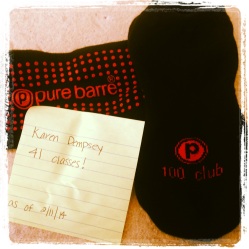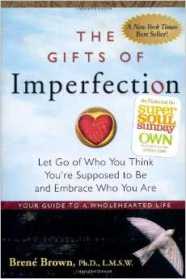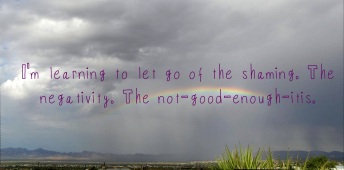 Vulnerability sounds like truth and feels like courage.
Vulnerability sounds like truth and feels like courage.
Truth and courage aren’t always comfortable, but they’re never weakness. 
Back in February, I set this small goal for myself: before Easter, I would attend 100 Pure Barre® classes at the studio here in Naples. And I did – I attended my 100th class on Good Friday, with two days to spare. For me, this is no small achievement. I am still in disbelief that I managed to accomplish this tiny feat (not to mention I got these “100 club” sticky socks for my feet).
As I have hit my mid-50s (in only a few short months I will be closer to 60), my listing of body trouble spots has grown to an impressive catalog –with bone spurs, herniated discs, menopause and osteoarthritis to name a few. I would love to say that these practical signs of aging are the reason I’ve been out of shape, lost my core strength, and gained a few pounds. And, when I’m practicing the art of self-compassion, I believe there is some truth to that.
But until recently, I haven’t been that compassionate towards myself, especially my body. Over the past 50-odd years, whenever I do think about my body, it generally is with strong feelings of shame and remorse. If only I was more perfect, was more athletic, ate the right foods, I would look better and be a better person. I’ve had shame-free moments, of course. Some even lasted for a few months. But, overall, when I think about it (and I hate thinking about it), I generally have been totally ashamed of my body for most of my life.
I won’t bore you with the litany of sins that my body reflects or its countless flaws. I often thought I learned about my body’s many shortcomings when it was too late to really do anything permanent about fixing them. I learned about these many defects through interaction with a variety of sources, including messages from family and friends, as well as mass media (including but not limited to: Noxzema commercials, the cover of Seventeen Magazine, the Sears Catalog and TV in general).
As it happens, I’ve spent the bulk of my life (well, since 1971) focused on my diet: I’m starting a diet Monday, I’m on a diet, I need to diet, I can’t thinking about a diet right now. I was always hesitant to be physically active as I had been teased (sometimes people can be unthinking) about how I looked (fat and/or stupid) when I rode my bike, ran, jumped or danced. Many felt the need to instruct me on what I should eat and exactly how I should exercise – because whatever I was doing was wrong, in their eyes. And I burned within from the shame of it all. I also hid – a lot. The scrutiny sucked the energy from me.
I had fleeting moments of “success” at different stages of my life and deep panic as I struggled in vain to maintain a certain weight. But, overall, the idea of “healthy striving” was foreign to me and the goal was always unachievable: perfection. Judgment, shame, and blame framed my view of my body. Despite the fact that I gave birth to a healthy son, finished college, law school, made partner at the firm, finished grad school, and managed to teach for 5 years, my body (which houses my mind, heart and spirit) was disgraceful, loathsome, vile. I have pretty much talked to myself using these words on a daily basis for more than 40 years.
The two men in my life – my husband and son – are the antithesis of me. My husband, despite his years, is an adept tennis player, swimmer, biker and hitter of groundballs. My son is a certified personal trainer who fields ground balls and played soccer and baseball in high school. In fact, I don’t believe there are many sports my son doesn’t like, except maybe curling. These two can get me on a tennis court (if no one else is playing) but I usually try to wiggle out of it somehow. I’m petrified at anyone watching me swing a tennis racket, despite my husband’s encouraging words and shouts of, “great hit.” My husband and son find me beautiful. But I don’t believe them most of the time.
I am still slightly shocked that I ever walked into the Pure Barre® studio.
Upon reflection, I think it has something to do with this work I started doing (imperfectly) on perfectionism, thanks to Brene’ Brown (check out The Gifts of Imperfection – it is a goldmine!). I picked the book up in Target to give as a gift – and kept it. As I have aged, I have grown so cynical about the “self help” books and theories as I find it all a bit self-absorbed. But what is more self-centered than the human who spends so much time seeking the unattainable? The idea that my flaws could be viewed as gifts was the hook. So I’ve read the book. And for me, it has been so helpful. Brown provides “ten guideposts” to help cultivate what she describes as a whole-hearted life. The book is pragmatic, short, to the point, and full of resources and ideas that can help us change how we live our lives. Not overnight, mind you. Like Brown’s book “Daring Greatly,” The Gifts of Imperfection focuses on the power of being authentic and vulnerable.
God, I hate not to be invulnerable. Really. I must be indomitable. A badass. Goes with my big ass. Vulnerability is not intuitive, let alone the concept that perfectionism is anything but the ideal. And authenticity? As Brene’ admits, it is not always the safe option. For me, a daunting choice. So much risk when I put myself out there. The pursuit of perfection is the “perfect” suit of armor. Who can criticize me when I already am criticizing myself?
I have come to believe that, as Brene’ so wisely points out, seeking perfection is soul-sucking and obstructive and self-destructive. Perfection is unattainable, but if it is our primary goal, it leads to self-blame (and self-centeredness): “I’m not good enough.” Brown makes perfect sense to me when she writes that we need to embrace our imperfections to find our “truest gifts: courage, compassion and connection.”
So I’ve started to work on overcoming my desire to be perfect and to become a “good enoughist.” And I started in my most vulnerable, imperfect place: my body.
I’d done the BMI calculations and checked out the weight/height charts and knew that I was hovering on being unhealthy. I needed to exercise and eat a healthy diet. I worked to incorporate some fruits and veggies and more protein into my diet. I added regular exercise: I rode my bike (wore dark sunglasses) and took Pilates (small or private classes so no one could see me) but had to stop Pilates because of bone spurs in my right shoulder. Honestly? I think I was hiding out in these forms of exercise and I wasn’t being “self-compassionate.” In a way, I was still suffering from total perfection paralysis.
But one morning, after refusing to play tennis (again – worried about what the real players would think), I stared in the mirror at my aging 50-something face (artfully lined by life’s unalterable progression) and thought, “why do I work so hard at not working out rather than work hard at working out?” So, rather than just agreeing philosophically with the guideposts in The Gifts of Imperfection, I actually began to deliberately and intentionally practice Brene’ Brown’s formula (she doesn’t say it this way exactly but it helps me to think of it this way) for letting go of perfection: (1) engaging in self-kindness (“I am trying my best”), (2) understanding that feelings of personal inadequacy are part of the human experience (“I am never alone in my struggles”) and (3) being mindful of, but not exaggerating my “painfail” emotions (I recognize my feelings but I try not to be “swept away by negative reactivity.”). Practice is the key word here – some days are better than others, and I often am reminded of that phrase “fake it ‘til you make it.”
So – I walked into Pure Barre® Naples last November. It was risky and I felt ever so vulnerable. I chose Pure Barre® because I love to dance (it is a low-impact, full body workout based in part on ballet) and I love losing myself in music. Of course, I took the introductory class first (the one that teaches you the basics so you can move precisely and perfectly (ahem – I added those “p” words) when you actually take a regular class…) but then signed up for ten classes. And then for a month of unlimited classes…every month. I loved it but I really had to work hard at self-kindness (you do look in the mirror a lot and I had been hiding not just from others but myself – lord, my butt is huge – but booty’s are in, right?). The studio set up is about a common humanity – the group classes are about a community working toward strength, energy and good health, all to the beat of the music. The instructors are all incredible, supportive and encouraging (every time I hear an instructor call out: “great form, Karen,” it still takes a minute to realize they are talking to me). The idea is that the 55 minutes at the Barre is a “time for you.” It is not about comparing my body or my ability to someone else’s. It is not about reaching some impossible standard. It is about my physical well-being and me. What a magical gift. I even began to dress differently for class after the first month – hiding in baggy clothes didn’t help my form. And yes, my body is still imperfect and flawed. But it is getting stronger and it feels healthier every day. And I’m not hiding it so much anymore.
And sure, a few people in my life have freely offered some negative critique of my new-found joy in working out at Pure Barre® (and yes, they are poking at my vulnerability) and I’ve had to work hard on my “shame-resilience.” But, after attending 100 classes, I realize I own this piece of my life. And somehow, through a daily (sometimes hourly) practice of self-compassion, I achieved a minor milestone. I am looking forward to more moments like these, but I am savoring and celebrating this moment. Because many days I might still feel afraid, but still, more and more days I feel grateful and joyous – and very brave and very alive. Maybe I can be a courageous and vulnerable badass.









So grateful for your comment, Bob. You and Mr. Berry are wise and observant. I can be such a traditional “baby boomer,” greatly influenced by the ideals presented by Madison Avenue to the point where it takes me ever so long to untangle my thinking. Talk about the “distraction of a lifetime!” I am struck by the fact that Mr. Berry’s words were first published in 1977 and here we are 37 years later – and his words ring with truth and clarity. Time for me to grab this book. Thank you.
LikeLike
Thus our young people are offered the ideal of health only by what they know to be lip service. What they are made to feel forcibly, and the measure themselves by, is the exclusive desirability of a certain physical model. Girls are taught to be leggy, slender, large-breasted, curly-haired, unimposingly beautiful. Boys are instructed to be “athletic” in build, tall but not too tall, broad-shouldered, deep-chested, narrow-hipped, square-jawed, straight-nosed, not bald, unimposingly handsome. Both sexes should look what passes for “sexy” in a bathing suit. Neither, above all, should look old.
Though many people, in health, are beautiful, very few resemble these models. The result is widespread suffering that does immeasurable damage both to individual persons and to society as a whole. The result is another absurd pseudo-ritual, “accepting one’s body,” which may take years or may be the distraction of a lifetime. Woe to the man who is short or skinny or bald. Woe to the man with a big nose. Woe, above all, to the woman with small breasts or a muscular body or strong features; Homer and Solomon might have thought her beautiful, but she will see her own beauty only by a difficult rebellion. And like the crisis of identity, this crisis of the body brings a helpless dependence on cures. One spends one’s life dressing and “making up” to compensate for one’s supposed deficiencies. Again, the cure preserves the disease. And the putative healer is the guru of style and beauty aid. The sufferer is by definition a customer.
…Wendell Berry, “The Body and the Earth,” The Unsettling of America,
Sierra Club Books, 1977 p 112
LikeLiked by 1 person